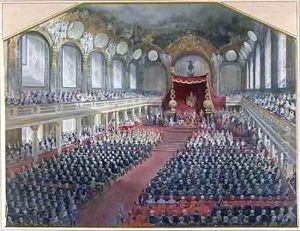Jean-Louis David Paintings
Jacques-Louis David, a preeminent figure in Neoclassical painting, was born on August 30, 1748, in Paris, France. His artistic journey, deeply intertwined with the political upheavals of his time, mirrored the tumultuous events of the French Revolution and the Napoleonic era. David's early life was marked by tragedy, with his father killed in a duel when David was only nine years old. Despite this, he showed an early affinity for art and was sent to study with François Boucher, a distant relative and a leading painter of the Rococo style. Boucher, recognizing David's talent and the shift in artistic tastes, directed him to his student Joseph-Marie Vien, a proponent of the emerging Neoclassical style, which sought to revive the ideals of ancient Greek and Roman art.
David's commitment to Neoclassicism was cemented during his time at the Royal Academy and his subsequent study trip to Rome, funded by the prestigious Prix de Rome scholarship he won in 1774. It was in Rome that David was deeply influenced by the ancient ruins and the works of Renaissance masters. His style evolved, emphasizing simplicity, clarity, and moral virtue, qualities that would define Neoclassical art. David's breakthrough came with his painting 'The Oath of the Horatii' (1784), which received critical acclaim for its stark depiction of Roman virtue and patriotism—a stark contrast to the frivolous Rococo style that preceded him. This painting, along with 'The Death of Socrates' (1787), showcased David's ability to convey moral messages, aligning with Enlightenment ideals.
David's art and political life were deeply intertwined. A supporter of the French Revolution, he became an active participant in its events, aligning himself with the Jacobins and his friend Maximilien Robespierre. During the Revolution, David's work took on a more overt political tone; he painted influential leaders and martyrs of the cause, such as 'The Death of Marat' (1793), capturing the assassination of the revolutionary leader Jean-Paul Marat. This period also saw David's involvement in revolutionary politics, including serving on committees and organizing national festivals, which used visual arts as propaganda tools.
However, the fall of Robespierre and the Jacobins in 1794 led to David's imprisonment. After his release, he aligned himself with Napoleon Bonaparte, becoming the First Painter to the Emperor. During this time, David produced iconic works like 'The Coronation of Napoleon' (1807), which played a crucial role in crafting Napoleon's image. Despite his success, the fall of Napoleon in 1815 marked the decline of David's political and social fortunes. In the aftermath, he was exiled to Brussels, where he spent the last years of his life, continuing to paint until his death on December 29, 1825.
David's legacy is profound, influencing the course of Western art. His emphasis on moral seriousness, adherence to classical ideals, and the integration of politics and art set the stage for modern art movements and left an indelible mark on the cultural landscape of France and beyond. Through his pupils and followers, David's Neoclassical style propagated, shaping the aesthetics and ideals of the 19th century. As a painter, political activist, and teacher, Jacques-Louis David remains a towering figure in the history of art, whose works continue to be celebrated for their powerful imagery and historical significance.
